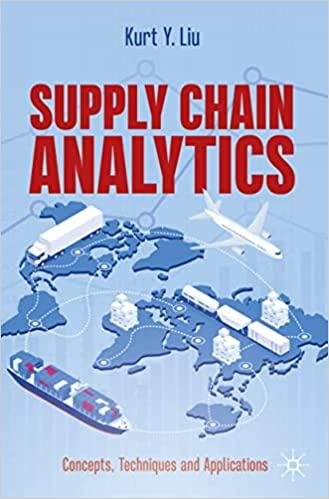Question
Using the AMPS Model to Address the Question of Bankruptcy Risk The video you watched from Chapter 11 provides description of how the AMPS model
Using the AMPS Model to Address the Question of Bankruptcy Risk
The video you watched from Chapter 11 provides description of how the AMPS model can be applied to a particular question such as presented in the project from your textbook. We will be following the same model, addressing a different question.
Utilizing the data file xapply the AMPS model to answer the question, "Which companies are most likely to go bankrupt?" Note that you will be applying the strategies and tools learned throughout this course to answer this question. Utilize your textbook and the tools learned in the labs.
Prepare one Word document to compile all of the Deliverables.
Ask the Question
You have been approached by an investor considering restructuring their investments. This investor has asked, "Which companies are most likely to go bankrupt?"
Master the Data
Step 1: Identify the data types of the provided data set. Refer to Chapter 3 and the data dictionary below.
Deliverable 1 ("Variables"): Identify the data types of the provided data (categorical or numerical, nominal, ordinal, interval, or ratio). List four variables that you think will help predict bankruptcy risk.
gvkeyA unique code for each company given by Compustat, the data provider for this financial statement dataconmCompany namefyearFiscal yearactCurrent assets ($ millions)atTotal assets ($ millions)ebitEarnings before interest and taxes ($ millions)lctCurrent liabilities ($ millions)ltTotal liabilities ($ millions)niNet income ($ millions)reRetained earnings ($ millions)saleNet sales ($ millions)MEMarket value of equity ($ millions)Perform the Analysis
Step 2: What kind of analysis will help determine which companies are most at risk of bankruptcy? Consider the following types of analyses: Ratio analysis, Pivottables, Histograms (Lab 2-5), and Trend analysis.
Deliverable 2 ("Analysis"): Prepare an analysis that includes the following items.
-
-
- Screenshot of additional columns added to your data file (ratio analysis). What ratios would be helpful in assessing default risk? What is your interpretation of the findings?
- Screenshot of at least two pivottable analyses and your interpretation.
-
Share the Story
Step 3: Consider how to present your findings explaining bankruptcy risk to the investor.
Deliverable 3 ("Final Report"): Prepare a one-page executive summary including the following sections. Further description of an executive summary can be found on page 542.
-
-
- Statement of the problem or opportunity that initiated the project.
- A concise description of how the project impacts the audience.
- Summary of the results utilizing graphs or pivottables.
- Brief recommendation(s).
-
Prepare one Word document to compile Deliverables 1 through 3. Submit it below.
Using the AMPS Model to Address the Question of Bankruptcy Risk
The video you watched from Chapter 11 provides description of how the AMPS model can be applied to a particular question such as presented in the project from your textbook. We will be following the same model, addressing a different question.
Utilizing the data file Project 1 Data.xlsx Download Project 1 Data.xlsxapply the AMPS model to answer the question, "Which companies are most likely to go bankrupt?" Note that you will be applying the strategies and tools learned throughout this course to answer this question. Utilize your textbook and the tools learned in the labs.
Prepare one Word document to compile all of the Deliverables.
Ask the Question
You have been approached by an investor considering restructuring their investments. This investor has asked, "Which companies are most likely to go bankrupt?"
Master the Data
Step 1: Identify the data types of the provided data set. Refer to Chapter 3 and the data dictionary below.
Deliverable 1 ("Variables"): Identify the data types of the provided data (categorical or numerical, nominal, ordinal, interval, or ratio). List four variables that you think will help predict bankruptcy risk.
gvkeyA unique code for each company given by Compustat, the data provider for this financial statement dataconmCompany namefyearFiscal yearactCurrent assets ($ millions)atTotal assets ($ millions)ebitEarnings before interest and taxes ($ millions)lctCurrent liabilities ($ millions)ltTotal liabilities ($ millions)niNet income ($ millions)reRetained earnings ($ millions)saleNet sales ($ millions)MEMarket value of equity ($ millions)Perform the Analysis
Step 2: What kind of analysis will help determine which companies are most at risk of bankruptcy? Consider the following types of analyses: Ratio analysis, Pivottables, Histograms (Lab 2-5), and Trend analysis.
Deliverable 2 ("Analysis"): Prepare an analysis that includes the following items.
-
-
- Screenshot of additional columns added to your data file (ratio analysis). What ratios would be helpful in assessing default risk? What is your interpretation of the findings?
- Screenshot of at least two pivottable analyses and your interpretation.
-
Share the Story
Step 3: Consider how to present your findings explaining bankruptcy risk to the investor.
Deliverable 3 ("Final Report"): Prepare a one-page executive summary including the following sections. Further description of an executive summary can be found on page 542.
-
-
- Statement of the problem or opportunity that initiated the project.
- A concise description of how the project impacts the audience.
- Summary of the results utilizing graphs or pivottables.
- Brief recommendation(s).
-
Prepare one Word document to compile Deliverables 1 through 3. Submit it below.
https://canvas.mccneb.edu/courses/42617/files/6226891?wrap=1
Step by Step Solution
There are 3 Steps involved in it
Step: 1

Get Instant Access to Expert-Tailored Solutions
See step-by-step solutions with expert insights and AI powered tools for academic success
Step: 2

Step: 3

Ace Your Homework with AI
Get the answers you need in no time with our AI-driven, step-by-step assistance
Get Started


